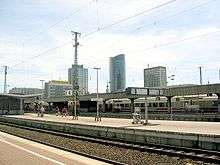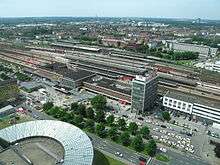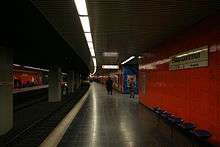Dortmund Hauptbahnhof
| Junction station | |
|
| |
| Location |
Königswall 15, Dortmund, North Rhine-Westphalia Germany |
| Coordinates | 51°31′3″N 7°27′32″E / 51.51750°N 7.45889°ECoordinates: 51°31′3″N 7°27′32″E / 51.51750°N 7.45889°E |
| Line(s) | |
| Platforms | 16 |
| Other information | |
| Station code | 1289[1] |
| DS100 code | EDO[2] |
| IBNR | 8000080 |
| Category | 1[1] |
| Website | www.bahnhof.de |
| History | |
| Opened | 1847[3] |
| Key dates | |
| 1910 | rebuilt |
| 1944 | destroyed |
| 1952 | rebuilt |
| Traffic | |
| Passengers | 130,000 daily[4] |
Dortmund Hauptbahnhof is the main railway station in Dortmund, North Rhine-Westphalia, Germany. The station's origins lie in a joint station of the Köln-Mindener Eisenbahn and Bergisch-Märkische Eisenbahn which was built north of the city centre in 1847. That station was replaced by a new station, erected in 1910 at the current site. It featured raised embankments to allow a better flow of traffic. At the time of its opening, it was one of the largest stations in Germany. It was, however, destroyed in an Allied air raid on 6 October 1944.
The main station hall was rebuilt in the year 1952 in a contemporary style. Its stained glass windows feature then-common professions of Dortmund.
The station has over 600 departing trains on a typical weekday.[5]
History
The original Dortmund station was built north of the city centre by the Cologne-Minden Railway Company (Cöln-Mindener Eisenbahn-Gesellschaft, CME) as part of its trunk line and opened on 15 May 1847. Two years later the Bergisch-Märkische Railway Company (Bergisch-Märkische Eisenbahn-Gesellschaft, BME) opened its station as a purely terminating station south of the existing station at the end of its main line to Elberfeld (now Wuppertal), its line to Soest (from 1855) and its Ruhr route to Duisburg and Oberhausen (from 1860).
The original station building, which was built on an island between the tracks with its access from Burgtor, was replaced in 1910 by a new large building at its current location. The new station was opened on 12 December 1910. The tracks had been raised to remove the obstruction of road traffic at level crossings. This second Hauptbahnhof in Dortmund was one of the largest of the former German Empire when it opened. On 6 October 1944, it was destroyed in an Allied bombing raid.
The entrance building of Dortmund Hauptbahnhof was replaced in 1952 by a functionalist building. It is regarded as architecturally insignificant, but it has significant stained glass windows on the theme of the former industrial specialisations of Dortmund. Five large stained glass windows document the Dortmund economy. In the middle one the city is shown, flanked to the left and right by a steelworker, a blast furnace worker, a brewer and a bridge builder. During the reconstruction of the station they were removed and the put on exhibition at the Hattingen Henrichshütte (a former steel works, which is partly used as a museum of industry). They were replaced with exact copies.[6]
Dortmund Hauptbahnhof originally housed a movie theatre. The Live Station discothèque was established in this former cinema in 1986. In April 2009, the nightclub was closed in the course of preparations for the reconstruction.
 The original station in 1870
The original station in 1870 The new station of 1910
The new station of 1910 The station during the occupation of the Ruhr in September 1924
The station during the occupation of the Ruhr in September 1924
Reconstruction and rehabilitation



The reconstruction of the Dortmund Hauptbahnhof has been under discussion since 1997. The original plan for a residential area in the form of an "oversized UFO" (80,000 square metres of usable space) was rejected. On 7 October 1998 a memorandum of understanding had been signed between Deutsche Bahn, the state of North Rhine-Westphalia and Westdeutsche Immobilien Bank. The Deutsche Mark (DM) 850 million project was to be completed by 2002.[7]
After the plans for the so-called "Dortmund UFO" were dropped, a new investor was found in 2001 in the form of the Portuguese investment group Sonae Imobiliaria. The DM 1.2 billion project was to be completed by 2006 and new designs were commissioned from architectural firms in the first quarter of 2001.[8] The new proposed development was called "3do" (3 Dortmund). € 75 million of federal and € 55 million of state funds were pledged. It was planned to have 36,000 square metres of retail and 26,500 square metres of entertainment space. On 3 February 2006, the Essen branch of the Federal Railway Authority (Eisenbahn-Bundesamt) approved the plans for "3do". On 28 February 2007, Deutsche Bahn announced that the investor was unwilling to commit to the project.
Through plans for the reconstruction of the station have twice failed, Dortmund Hauptbahnhof suffers significantly from neglect. Only the terminating platforms (tracks 2–5) and the platform of S-Bahn lines S1 and S2 (tracks 6 and 7) have a lift.
The reconstruction and rehabilitation of the Dortmund Hauptbahnhof began in summer 2009. In a first phase, the station building and related operational areas were gutted. During construction the ticket office and a restaurant of a fast-food chain were placed in containers outside the station. The federal police station and the Bahnhofsmission (a German charity focussed on railway stations) were also placed in containers on the north side. On 17 June 2011, the first phase was formally completed. Of the total cost of € 23 million, the federal government contributed € 13.3 million, the state € 1.4 million and the Deutsche Bahn € 8.3 million.[9]
In a second phase, which begins in 2014 and will not be completed until 2017,[10] the station tunnels and the entrances to the platforms will be renewed. Dortmund is one of the few big-city stations in Germany where access to the platforms has not yet made accessible for the disabled. In the course of these alterations the eastern access to the tunnel linking the station’s buildings and platforms will also be rebuilt. At the same time it is also intended that there will be improvements to facilitate the introduction of the Rhine-Ruhr Express (a planned upgrade to North Rhine-Westphalia’s Regional-Express network).[11] This will require a comprehensive restructuring of the track layout in Dortmund Hauptbahnhof.
Services
Long distance trains
Dortmund Hauptbahnhof is served by Thalys, Deutsche Bahn Intercity-Express and Intercity services.
| Preceding station | Thalys | Following station | ||
|---|---|---|---|---|
toward Paris-Nord | Thalys | Terminus | ||
| Preceding station | Deutsche Bahn | Following station | ||
| ICE 10 | towards Berlin-Gesundbrunnen |
|||
towards Munich Hbf | ICE 31 train route splits here and rejoins in Köln Hbf | towards Kiel Hbf |
||
towards Munich Hbf |
||||
towards Munich Hbf | ICE 41 | Terminus | ||
| ICE 42 | towards Hamburg-Altona |
|||
towards Basel SBB | ICE 43 | towards Hannover Hbf |
||
towards Wien Hbf | ICE 91 train route splits here and rejoins in Köln Hbf | Terminus | ||
towards Wien Hbf |
||||
towards Cologne Hbf | IC 26 Köln-Hamburg | towards Hamburg-Altona |
||
towards Chur | IC/EC 30 | towards Ostseebad Binz or Seebad Heringshof |
||
towards Passau Hbf | IC/EC 31 | |||
towards Innsbruck Hbf | IC/EC 32 | towards Berlin Südkreuz |
||
towards Cologne Hbf | IC 51 | towards Ostseebad Binz |
||
towards Cologne Hbf | IC 55 | towards Dresden Hbf |
Regional trains
Regional-Express and Regionalbahn services:
| Preceding station | Deutsche Bahn | Following station | ||
|---|---|---|---|---|
toward Aachen Hbf | RE 1 NRW-Express | toward Paderborn Hbf |
||
toward Aachen Hbf | RE 4 Wupper-Express | Terminus | ||
toward Düsseldorf Hbf | RE 6 Westfalen-Express | toward Minden Hbf |
||
toward Mönchengladbach Hbf | RE 11 Rhein-Hellweg-Express | toward Hamm Hbf |
||
| Terminus | RE 57 Dortmund-Sauerland-Express | toward Winterberg and Brilon Stadt |
||
| RB 52 Volmetalbahn | toward Lüdenscheid |
|||
| RB 53 Ardey-Bahn | toward Iserlohn |
|||
| Preceding station | eurobahn | Following station | ||
toward Düsseldorf Hbf | RE 3 Rhein-Emscher-Express | toward Hamm Hbf |
||
Dortmund-Kirchderne toward Münster Hbf | RB 50 Der Lüner | Terminus | ||
| Terminus | RB 59 Hellweg-Bahn | toward Soest |
||
| Preceding station | NordWestBahn | Following station | ||
toward Dorsten | RB 43 Emschertal-Bahn | Terminus | ||
| Preceding station | Prignitzer | Following station | ||
Dortmund-Kirchderne toward Enschede | RB 51 Westmünsterland-Bahn | Terminus |
S-Bahn trains
Rhine-Ruhr S-Bahn services:
| Preceding station | Rhine-Ruhr S-Bahn | Following station | ||
|---|---|---|---|---|
toward Solingen Hbf | S 1 | Terminus | ||
| S 2 | ||||
toward Hagen Hbf | S 5 |
Light rail

Light rail services are operated by the Dortmund Stadtbahn.
| Preceding station | Rhine-Ruhr Stadtbahn | Following station | ||
|---|---|---|---|---|
Leopoldstraße
toward Brambauer Verkehrshof | U41 | Kampstraße
toward Clarenberg |
||
| Terminus | U45 | Kampstraße
toward Westfalenhallen |
||
Leopoldstraße
toward Dortmund-Westerfilde | U47 | Kampstraße
toward Aplerbeck |
||
Leopoldstraße
toward Hafen | U49 | Kampstraße
toward Hacheney |
∗ U45 becomes at the station Westfalenhallen the line U46 and continues to Brunnenstraße. On match days of the Borussia Dortmund soccer club the line ends instead of the regular terminus Westfalenhallen at the Westfalenstadion station, which is only open on these occasions. In this case it does not continue as U46.
References
- 1 2 "Stationspreisliste 2016" [Station price list 2016] (PDF) (in German). DB Station&Service. 1 December 2015. Retrieved 24 January 2016.
- ↑ Eisenbahnatlas Deutschland (German railway atlas) (2009/2010 ed.). Schweers + Wall. 2009. ISBN 978-3-89494-139-0.
- ↑ "Dortmund-Dorstfeld Hbf operations". NRW Rail Archive (in German). André Joost. Retrieved 29 April 2016.
- ↑ Reisen, Service und Shopping für täglich 125.000 Reisende und Besucher . Information auf bahnhof.de, accessed 13 December 2008
- ↑ "Dortmund Hbf train schedules". Trainline International. Retrieved 17 February 2016.
- ↑ "Alte Bahnhofsfenster wieder neu" (in German). Der Westen. 17 December 2009. Retrieved 20 August 2011.
- ↑ "Neuer Hauptbahnhof für Dortmund". Eisenbahn-Revue International (in German) (11/1998): 451. ISSN 1421-2811.
- ↑ "Aktuelles in Kürze". Eisenbahn-Revue International (in German) (3/2001): 106. ISSN 1421-2811.
- ↑ "Wiedereröffnung Empfangsgebäude Dortmund Hauptbahnhof" (Press release) (in German). DB Mobility Logistics AG. 17 June 2011. Retrieved 20 August 2011.
- ↑ "Umbauarbeiten nicht vor 2017 beendet" (in German). Ruhr Nachrichten. 8 October 2010. Retrieved 20 August 2011.
- ↑ "Kaum Neues vom RRX" (in German). Der Westen. November 2009. Retrieved 20 August 2011.